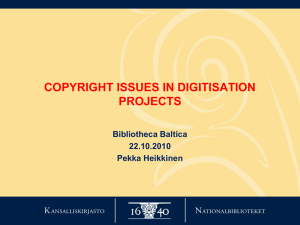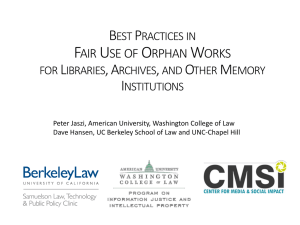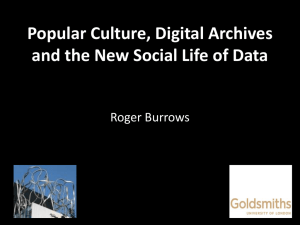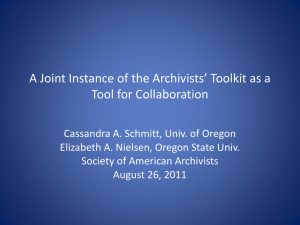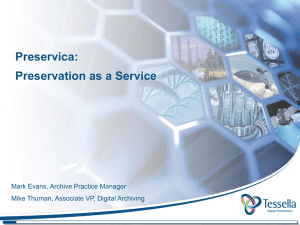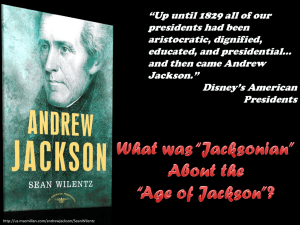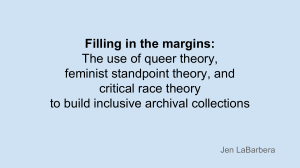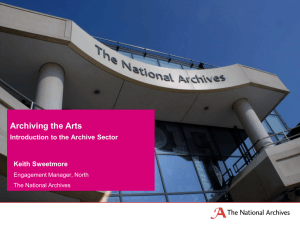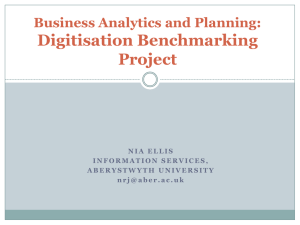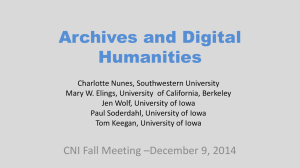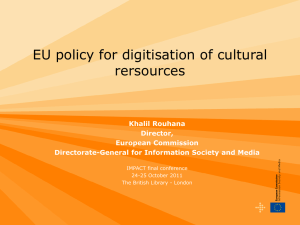than just Data Standards
advertisement
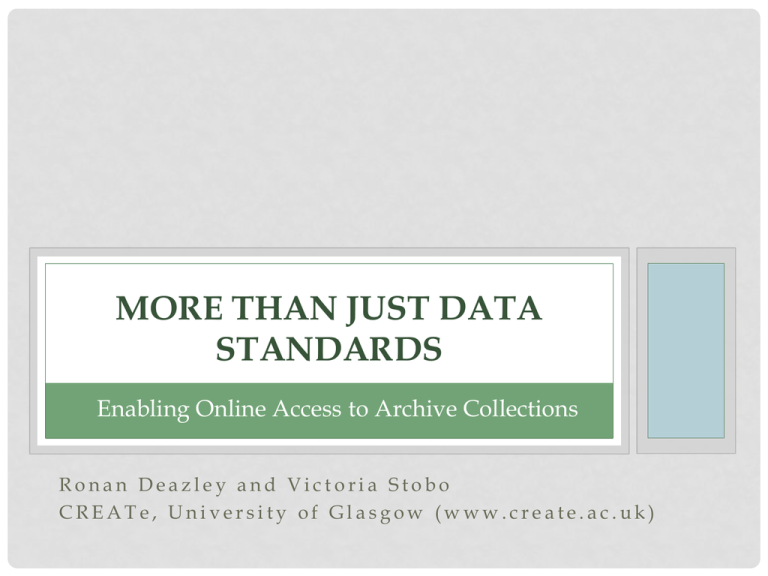
MORE THAN JUST DATA STANDARDS Enabling Online Access to Archive Collections Ronan Deazley and Victoria Stobo CREATe, University of Glasgow (www.create.ac.uk) WE NEED TO TALK ABOUT THE ‘C’ WORD * [* Copyright] Ronan Deazley and Victoria Stobo CREATe, University of Glasgow (www.create.ac.uk) RCUK Centre for Copyright and New Business Models in the Creative Economy CREATe is a pioneering interdisciplinary initiative, and globally the first effort to investigate the relationship between Creativity, Regulation, Enterprise and Technology (=CREATe) through the lens of copyright law The research programme has a strong empirical and interdisciplinary focus, with 40 projects to be delivered over the next three years by a team including lawyers, economists, computer scientists, sociologists, psychologists, ethnographers and archivists DIGITISING ARCHIVE COLLECTIONS Digitising archive collections necessarily triggers concerns about copyright, and rightly so ... Universal Declaration on Archives (2010) We undertake to work together in order that: Archives are made accessible to everyone, while respecting the pertinent laws and rights of individuals, creators, owners and users Copyright: “the perennial hornet’s nest for archivists” Terry Cook, 1984 THE NEED TO CLEAR RIGHTS Digitising archive collections involves making copies and communicating those copies to the public: two of the economic rights protected by copyright (CDPA, s.16) So: unless the work is in the public domain (out of copyright), or an appropriate exception to copyright applies, you need to clear rights DURATION OF COPYRIGHT AND THE PUBLIC DOMAIN There are lots of different copyright terms, but typically works of literature, drama, music and art are protected for the life of the author plus seventy years after her death CDPA, Schedule 1(12) (Saving and Transitional Provisions) For authors of literary, dramatic and musical works who died before 1969, and whose work remained unpublished on 1 August 1989 (when the CDPA came into force) the work remains in copyright until 31 December 2039 This holds true regardless of when the work was created, and even if it was created before copyright (as we know it) existed EXCEPTIONS TO COPYRIGHT The exceptions that currently apply to libraries and archives enable preservation and copying for users, but not making available online (CDPA, ss.37-43) The government have been consulting on reform of the copyright regime since 2006 (the Gowers Review) and reforms are coming … Section 43A (Making work available on dedicated terminals) Libraries, educational institutions, museums and archives can digitise to make available on a dedicated terminal on site, if the work: (i) has been lawfully acquired; (ii) is made available for non-commercial research or private study THE REALITY OF CLEARING RIGHTS The cost of rights clearance often outstrips both digitisation and the monetary value of the work itself Rights clearance procedures impose prohibitive burdens on cultural institutions In most cases, the results of rights clearance processes are unsatisfactory: rightsholders cannot be traced, or they do not respond The burden is greater for archives than for libraries, because their collections are significantly larger, and typically contain more orphan works THE REALITY OF CLEARING RIGHTS THE JON COHEN AIDS RESEARCH COLLECTION THE REALITY OF CLEARING RIGHTS THE JON COHEN AIDS RESEARCH COLLECTION Akmon, “Only with your permission” (2010) Archival Science 45 TOTAL ITEMS IN COPYRIGHT 5,463 (of 13,381) No. of Copyright Owners 1,377 Copyright Owners traced 87% Replied 79% of those traced Permission granted 95% of respondents Permission denied 5% of respondents Non Response 18% (981 items) Orphan Works 13% (687 items) 1,973 items (36%) were not made available online THE REALITY OF CLEARING RIGHTS THE THOMAS E. WATSON PAPERS THE REALITY OF CLEARING RIGHTS THE THOMAS E. WATSON PAPERS Dickson, “Due Diligence, Futile Effort” (2010) The American Archivist 626 TOTAL ITEMS 7,253 in correspondence series Correspondent List 3,304 Confirmed/Possible Identifications 3,280 Died before 1939 608 (19%) Died after 1939 1,101 (33%) Uncertain 1,571 (48%) Reliable contact details 4 correspondents Permission granted 3 (75%) Non Response 1 (25%) THE REALITY OF CLEARING RIGHTS THE THOMAS E. WATSON PAPERS Dickson, “Due Diligence, Futile Effort” (2010) After investing approx. $8000 in rights clearance activity (or $1,050 per linear foot of correspondence) they were able to make 21% of the material available online, and largely because that material was out of copyright Only 4 letters that were known to be in copyright were made available online (permission granted) Total return on investment: $2,000 per item ORPHAN WORKS A work is an orphan work if the copyright owner(s) cannot be identified or located by someone seeking permission to make use of the work (e.g., copy and communicate online) Works become ‘orphaned’ for a number of reasons: Copyright arises at the point of creation and is not contingent on any formalities, such as registration The length of the copyright term: tracking a chain of title over a long period of time can be incredibly complicated (and especially for unpublished works created by authors who died before 1969) ORPHAN WORKS SCHEMES EU UK TYPE OF SCHEME: Exception Licensing (non-exclusive) WHO BENEFITS: Cultural Institutions Everyone Books, newspapers, and so on (inc. embedded artistic works), films, audiovisual works and sound recordings Everything TYPE OF USE: Digitise and Display (non-commercial) Anything (commercial/non-commercial) CONDITIONS: Diligent Search Diligent Search Licence Fee (upfront) WHAT MATERIAL: ORPHAN WORKS THE PADFIELD ANALYSIS We have two wonderful new schemes for Orphan Works, one from the European Union and one from the UK government. Frankly, neither of them will be a great deal of use to archivists … Tim Padfield Retired (London, 27 September 2013) ORPHAN WORKS THE HIRTLE ANALYSIS This idea of diligent search for orphan works for archives just isn’t going to work; it’s way, way too expensive … Prof Peter Hirtle Senior Policy Advisor, Cornell University Library Research Fellow, Berkman Center for Internet & Society, Harvard (London, 27 September 2013) MANAGING THE COPYRIGHT PROBLEM (1) Dryden, “Copyright issues in the selection of archival material for internet access” (2008) Archival Science 123 Two-thirds of institutions did not select items involving third-party copyrights for inclusion in digitisation projects Develop digitisation strategies based on ease of copyright compliance So, either work with: (i) depositor copyright material; or, (ii) material in the public domain (but remember: CDPA, Schedule 1(12)) MANAGING THE COPYRIGHT PROBLEM (2) EMBRACE RISK* [* TAKE SENSIBLE RISKS ] DIGITISATION AND RISK Copyright clearance is about managing risk, always … Christy Henshaw Digitisation Programme Manager Wellcome Library (London, 27 September 2013) DIGITISATION AND RISK [D]ecisions about copyright clearance, when to do it, how to do it and how much to do, are always considerations based in the end on a vision of risk, and of risk tolerance in a particular institution … Prof Peter Jazsi Washington College of Law (London, 27 September 2013) DIGITISATION AND RISK There will always be some degree of risk … Natalie Adams Archivist and Information Services Manager Churchill Archives Centre (Glasgow, 25 February 2014) DIGITISATION AND RISK [A]rchivists’ masters expect people to be making material available and the public expects it, which means that the politicians expect it [A]rchivists are going to have to accept risk if they want to do the things that they want to do, and that, more to the point, the politicians want them to do Risk management [will] become more and more important … Tim Padfield (London, 27 September 2013) DIGITISATION AND RISK Digitising archive collections always involves risk … Ronan Deazley (London, 27 March 2014) (about 5 seconds from now) THE NATIONAL ARCHIVES THE OLYMPIC RECORD THE NATIONAL ARCHIVES THE OLYMPIC RECORD Olympic Games: Effects of persecution of Jews and possible boycott (1935) Catalogue Reference: FO/371/18863/7600 MANAGING THE COPYRIGHT PROBLEM (3) DEVELOP AN APPROPRIATE TAKEDOWN POLICY MANAGING THE COPYRIGHT PROBLEM (3) TNA: TAKEDOWN AND RECLOSURE POLICY Material will be taken down temporarily on receipt of a request from a member of the public or a government department. The case will then be considered by the Takedown Panel … The Takedown Panel will approve continued withdrawal of the material only if one of the following criteria is met: […] Making the material available online is an infringement of copyright THE NATIONAL ARCHIVES THE OLYMPIC RECORD Olympic Games: Effects of persecution of Jews and possible boycott (1935) Catalogue Reference: FO/371/18863/7600 AN APPETITE FOR RISK? From our point of view, we don’t think a stray newspaper clipping is a very high risk at all. An entire magazine is more of a high risk … Christy Henshaw (London, 27 September 2013) COPYRIGHT AND RISK CODEBREAKERS: MAKERS OF MODERN GENETICS COPYRIGHT AND RISK SCOPING THE WELLCOME DIGITAL LIBRARY Mass digitisation pilot project concerning the history of genetics in the 20th century (Crick, Watson, et al) incorporating both library (commercially published) and archive material Five other archives involved in the project: KCL, UCL, Churchill Archives, Cold Spring Harbor, Glasgow University Wellcome Digital Library launched in 2012 with over 2M+ images available online With thousands of potential rights holders to consider, the Wellcome Library decided to adopt a risk-based approach to copyright compliance RISK CRITERIA CODEBREAKERS HIGH RISK MEDIUM RISK Author is a well-known literary figure, broadcaster, artist Author has (or had) a high public profile The author/estate/publisher is known to actively defend their copyright Author is alive and known to have a literary estate as recorded in the WATCH file The relationship between the institution and the author/estate/publisher is awkward The material appears to have been published or broadcast and/or prepared for commercial gain rather than to advance academic knowledge or in a not-for-profit context RISK-MANAGED RIGHTS CLEARANCE CODEBREAKERS: THE RESULTS NAMES IN COPYRIGHT DATABASE 160 Reliable contact details 134 84% of all rightsholders Total replies 103 77% of those contacted Permission granted 101 98% of respondents Permission refused 2 2% of respondents 26 19% of those contacted Low risk: put online after suitable delay 23 89% of non-respondents High risk: do not put online 3 11% of non-respondents Did not respond CODEBREAKERS SOME (OBVIOUS) LESSONS LEARNED WHEN ASKED, PEOPLE TEND TO GRANT PERMISSION Codebreakers: 98% of respondents Jon Cohen Project: 95% of respondents AND THEY DO SO WITHOUT SEEKING A FEE Codebreakers: 1 respondent requested a charitable donation be made (and this related to library not archival material); no-one asked for a fee in relation to the digitisation of archive material Jon Cohen Project: 1 respondent asked for a copyright fee; the library refused, and the owner subsequently granted permission THE GREATER YOUR APPETITE FOR RISK, THE MORE MATERIAL YOU CAN MAKE AVAILABLE ONLINE MANAGING THE COPYRIGHT PROBLEM (4) I recognise the need to accept risk but … I would urge archivists to make sure that they get approval from their senior management, rather than take any risk themselves Always get senior management agreement … Tim Padfield (London, 27 September 2013) AND YET … The biggest problem we have is our professional standards which say that archivists respect copyright law, and they don’t say: archivists respect copyright law unless they think they are unlikely to be sued and then they’ll do whatever they want Prof Peter Hirtle (London, 27 September 2013) ARCHIVES AND COPYRIGHT DEVELOPING AN AGENDA FOR REFORM www.create.ac.uk/archivesandcopyright/
